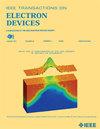Plasma-Free Nitridation for MOSCAPs and GeOI GAAFETs Utilizing Cyclic Passivation of Ozone/Hydrazine With Low Leakage Current, Low Interface Traps, and High Thermal Stability
IF 2.9
2区 工程技术
Q2 ENGINEERING, ELECTRICAL & ELECTRONIC
引用次数: 0
Abstract
Hydrazine (N2H4) plasma-free nitridation reacts on the interface layer oxidated by ozone, forming a high-quality GeON interfacial layer (IL) through alternating passivation. On metal-oxide-semiconductor capacitor (MOSCAP) with Al2O3/GeON gate stacked, the nitridation of N2H4 can effectively improve the interface quality and bring good electrical properties, such as low gate leakage current (利用臭氧/肼循环钝化低泄漏电流、低界面陷阱和高热稳定性的MOSCAPs和GeOI gaafet的无等离子体氮化
肼(N2H4)无等离子体氮化反应在被臭氧氧化的界面层上,通过交替钝化形成高质量的GeON界面层(IL)。在Al2O3/GeON栅极叠合的金属氧化物半导体电容器(MOSCAP)上,氮化N2H4可以有效地改善界面质量,并带来良好的电学性能,如在${V} _{\text {G}} = 1$ V处栅极漏电流低($3.27\乘以10^{-{5}}$ A/cm2),中缝处界面缺陷密度降低($8.59\乘以10^{{11}}$ cm $^{-{2}} \cdot \text {eV}^{-{1}}$)。此外,本工作还制作了层转移GeOI栅极全能场效应晶体管(GAAFET)来验证N2H4的IV特性。与NH3钝化器件相比,N2H4钝化器件具有更好的开/关比、阈值电压分布和热稳定性。GeOI GAAFET CMOS逆变器显示出更对称的特性,表明N2H4钝化适用于GAA结构器件。
本文章由计算机程序翻译,如有差异,请以英文原文为准。
求助全文
约1分钟内获得全文
求助全文
来源期刊

IEEE Transactions on Electron Devices
工程技术-工程:电子与电气
CiteScore
5.80
自引率
16.10%
发文量
937
审稿时长
3.8 months
期刊介绍:
IEEE Transactions on Electron Devices publishes original and significant contributions relating to the theory, modeling, design, performance and reliability of electron and ion integrated circuit devices and interconnects, involving insulators, metals, organic materials, micro-plasmas, semiconductors, quantum-effect structures, vacuum devices, and emerging materials with applications in bioelectronics, biomedical electronics, computation, communications, displays, microelectromechanics, imaging, micro-actuators, nanoelectronics, optoelectronics, photovoltaics, power ICs and micro-sensors. Tutorial and review papers on these subjects are also published and occasional special issues appear to present a collection of papers which treat particular areas in more depth and breadth.
 求助内容:
求助内容: 应助结果提醒方式:
应助结果提醒方式:


